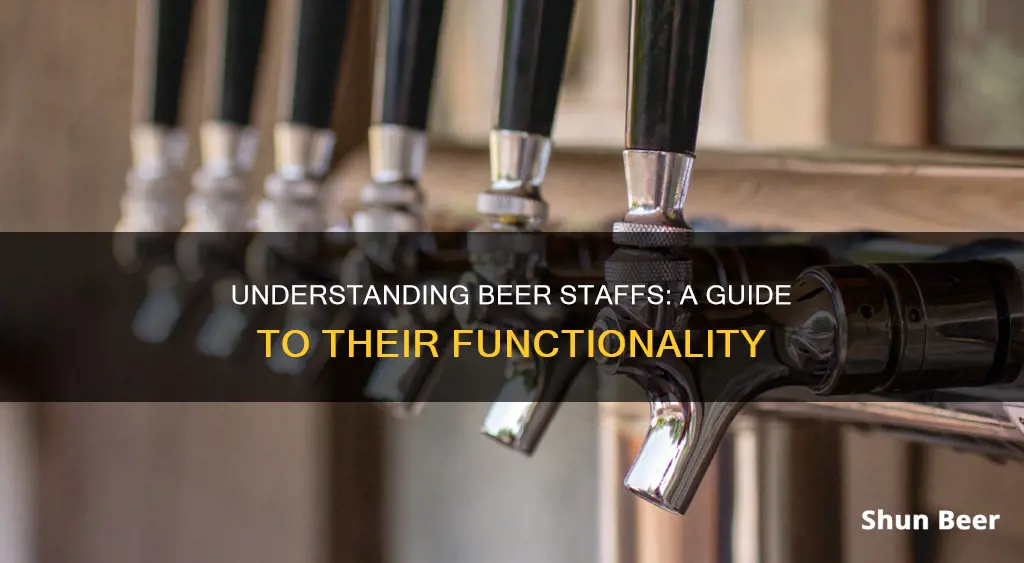
Beer taps, also known as draft systems or keg dispensers, are an integral part of serving beer in bars, pubs, and other establishments. The primary function of a draft beer system is to move the beer from the keg to the faucet in the shortest amount of time without damaging the product. This process involves connecting a pressurized keg to the tap system, maintaining specific temperatures, and applying dispensing pressure to ensure a smooth and controlled pour. The beer is then released from the tap by activating a valve, allowing it to flow into the glass.
What You'll Learn

Beer taps
A beer tap is a valve used to control the release of beer from a keg. The word "tap" is derived from the Old English word "tæppa", meaning "plug" or "stopper", and was originally used for wooden valves in traditional barrels. The use of the word "tap" for a beer valve is almost universal.
There are three main types of beer taps: gravity, pressurized, and hand pump or manual. The most common type is the gravity beer tap, which uses gravity to dispense the beer. The keg is placed on a raised platform and the tap is attached to a rubber hose that runs from the keg to the faucet. To pour a pint, the valve is opened, and gravity does the rest. Pressurized taps, on the other hand, use CO2 to push the beer from the keg to the faucet, and are generally used for draft systems located further away from the keg cooler. The CO2 tank is typically located next to the keg cooler and is connected to the keg via a pressure regulator. The third type, the hand pump or manual pump, uses manual labour to dispense the beer and is often used for portable draft systems or when CO2 is not available.
To tap a keg, the tap is connected to the metal ring at the top of the keg. The tap is turned clockwise until it feels secure, and then the handle is pushed down until it locks in. A few pumps are given, and then the beer is ready to be poured.
Beer Bar Memberships: Are They Worth the Cost?
You may want to see also

Beer lines
A beer line is a tube that carries draft beer from the keg to the tap handle in a draft beer dispensing system. Beer lines are typically made from vinyl, stainless steel, XFM, and barrier tubing. The type of beer line used depends on the type of draft beer system being used, and which part of the system the tubing is in.
There are two main types of draft beer systems: glycol beer systems (or long draw systems) and air-cooled/direct draw systems. Glycol beer systems are used to dispense beer at a faucet away from a beer walk-in cooler, such as at a bar. The beer is kept at a consistent temperature by a glycol chiller in the beer trunk line. Direct draw systems are found on wall-mount systems or kegerators, and use vinyl hoses and tubing.
The size and length of beer lines are carefully chosen to maintain the proper flow and temperature of the beer. The most common size is 3/8 inch inside diameter, which is used for beer walk-in jumper lines. Other common sizes include 1/4 inch and 3/16 inch inside diameter.
The Magic of Beer Widgets: How Do They Work?
You may want to see also

Temperature control
Beer taps, also known as draft systems or keg dispensers, play a crucial role in temperature regulation. These systems are designed to maintain the ideal serving temperature, ensuring that each pour is of the highest quality. The tap system often includes a refrigeration unit that cools the beer as it flows through, helping to achieve that refreshing, crisp taste that beer enthusiasts crave.
The size and length of the beer lines connecting the keg to the faucet are carefully selected to maintain the proper flow and temperature of the beer. These lines are typically made of food-grade materials, such as plastic or stainless steel, to ensure the beer remains uncontaminated.
Maintaining the proper temperature is not just about keeping the beer cold; it's about finding the sweet spot that brings out the best in the brew. Different beers have different ideal serving temperatures, and beer taps often feature temperature control mechanisms to fine-tune the chilling process and keep the beer within the desired range.
Additionally, the art of pouring beer involves specific techniques for different styles, as this can affect the head (foam) and the release of desired flavors and aromas. A skilled bartender knows that the perfect pour goes hand in hand with precise temperature control to create a delightful drinking experience.
Beano and Beer: Does the Enzyme Work?
You may want to see also

Carbonation
The best way to achieve uniform and rapid carbonation is twofold: first, ensure the proper amount of headspace, which is usually around 10-15%. Second, utilise a carbonation stone instead of alternative methods. Carbonation stones produce tiny microbubbles that are more readily absorbed by the beer, especially when the temperature is maintained between 30-33°F and the flow of CO2 is optimised.
The most common method of carbonation is to simply press CO2 into the beer under pressure. This is typically done after the beer has been fermented and cooled to around 0°C, marking the last step before packaging and storage. This process is known as forced carbonation.
Forced carbonation can be achieved by cooling the beer, placing it in a sealed container, and introducing CO2. By adjusting pressure and temperature, the gas is stably absorbed into the beer, resulting in the desired level of carbonation within a few days or a week.
Another method is "bottle conditioning", which involves creating carbonation through a small amount of fermentation in the bottle. This process is done by fermenting the beer completely until it is flat, priming it with a small amount of sugar, bottling it, and then waiting a couple of weeks for the secondary fermentation to take place.
The level of carbonation will decrease over time, and the beer may eventually lose its fizz unless it is stored under pressure and at a low temperature.
Beer Foam Stones: Do They Work?
You may want to see also

Maintenance
Regular maintenance is crucial to ensuring the smooth operation of a brewery and preventing quality issues, safety concerns, and increased costs. Here are some key maintenance practices for beer staffs:
- Routine Equipment Inspections: Regularly inspect brewing vessels, pumps, valves, hoses, gaskets, and other essential components for signs of wear, leaks, or corrosion. Use a maintenance log to track inspections and repairs.
- Ingredient Quality Control: Ensure the quality of grains, hops, yeast, and water by monitoring storage conditions and regularly rotating stock to maintain freshness.
- Equipment Cleaning and Sanitization: Clean and sanitize equipment after each use to prevent contamination and off-flavors. Use brewery-specific cleaners, thoroughly rinse, and sanitize with food-grade sanitizers. Pay extra attention to fermentation tanks, kegs, and beer-contact surfaces.
- Temperature and Humidity Control: Invest in reliable control systems to maintain optimal brewing conditions. Calibrate temperature sensors and thermostats, and monitor fermentation vessel temperatures to prevent yeast stress.
- Pipe and Line Maintenance: Regularly flush and clean pipes, tap lines, and draft lines to prevent blockages and ensure the final product's quality.
- Preventative Maintenance Schedule: Develop a schedule for lubricating moving parts, replacing worn-out components, calibrating gauges, cleaning valves, and inspecting and cleaning faucets.
- Emergency Repairs: Prepare for unexpected breakdowns by keeping spare parts, learning troubleshooting techniques, and having a list of reliable repair services.
- Safety Measures: Train staff in safe equipment operation, handling of chemicals and cleaning agents, and proper safety protocols to prevent accidents and injuries.
- Vessel Cleaning and Water Tests: Before each brew day, run hot water through the brewhouse system to check for leaks and ensure proper functioning. After brewing, use a CIP system and pressure washer to remove dirt, followed by a caustic wash and hot rinse.
- Malt Mill Maintenance: Clean the malt mill immediately after use to remove malt dust. Check the calibration before each brew day, and inspect the motor every couple of months.
- Electrical System Tests: Regularly check the wiring and components of the electrical control panel for signs of wear. Vacuum the inside to remove dust and ensure moisture protection.
- Tool Calibration: Calibrate essential tools like thermometers, pH readers, refractometers, and dissolved oxygen readers before brewing. Inspect the wiring of in-built temperature probes for moisture intrusion.
- Vessel Motor Maintenance: Strip down and inspect vessel motors every few months for signs of wear, rust, faulty wiring, worn threads, and loose bolts.
- Heating System Maintenance: Clean plate heat exchangers immediately after use and inspect the plates annually for a deep clean. Maintain your heating system according to its specific requirements (electric, steam, or direct fire).
- Cooling System Maintenance: Weekly, check for leaks in pipes and pumps of the cooling system. Inspect the electrical control panel for signs of wear or moisture intrusion. Test the panel to ensure proper cooling function.
- Fermenting Vessel Maintenance: Before filling, check that the fermenting vessels are holding pressure. Clean the outside of the vessels weekly and inspect gaskets, valves, and clamps during cleaning, replacing them as needed.
- Packaging Line Maintenance: Regularly apply food-grade grease to bottling or canning line moving parts and replace worn hoses. Inspect electrical components and ensure moisture doesn't enter the control panel.
- Workspace Maintenance: Clean and repair floors, walls, and ceilings to prevent accidents and mold growth. Maintain door seals in cold storage areas, fridges, and freezers, and test their thermostats.
- Water Filter Maintenance: Regularly inspect and replace water filters as needed.
Do Beer Cozies Work? The Science Behind It
You may want to see also
Frequently asked questions
Beer staff, or bartenders, work in bars, restaurants, hotels, and pubs. Their main duties include mixing, serving, and attending to customers. They are also responsible for keeping the bar area clean and maintaining a friendly and welcoming atmosphere. In addition, they need to have sufficient knowledge of alcoholic drinks and good communication and listening skills.
It is important to build a positive company culture and create an enjoyable workplace to keep beer staff motivated and engaged. This can be done by rewarding staff for their good performance, publicly recognizing their achievements, and providing opportunities for growth and advancement. Contests and incentives can also be effective in motivating staff to increase sales and improve customer service.
There are three main types of draft beer systems: Glycol Cooled Remote Beer System (Long-Draw), Air Cooled Beer System, and Direct Draw Beer System (Short-Draw). The primary function of all these systems is to move the beer from the keg to the faucet quickly and efficiently while maintaining the desired temperature. The Glycol Cooled Remote Beer System is the most complex and expensive option, suitable for long-draw dispensing setups. The Air Cooled Beer System uses circulating cold air to keep the beer cool and is a more cost-effective option. The Direct Draw Beer System is the most common and straightforward system, typically used for short distances between the keg and the faucet.







